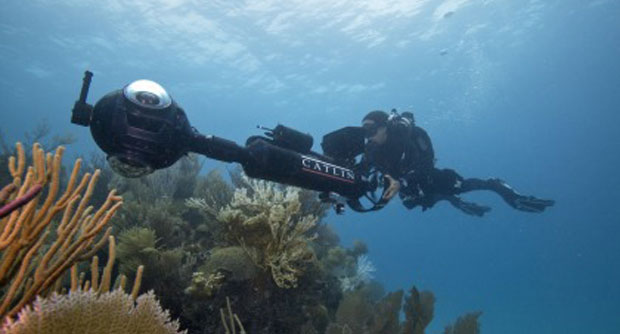Researchers from University of Queensland to study Tubbataha Reef

A high-resolution panoramic camera system mounted on an underwater scooter will be used to survey the Tubbataha Reefs Natural Park. Photo posted with permission from the Catlin Seaview Survey, Global Change Institute, University of Queensland
MANILA, Philippines – Researchers from the University of Queensland are expected to visit the Philippines this week to survey the Tubbataha coral reef, a World Heritage Site in Palawan.
In a statement on Wednesday, the group said it would use a panoramic camera system mounted on an underwater scooter to survey the vast coral reefs in the Tubbataha Reefs Natural Park.
The project is under the Catlin Seaview Survey of the university’s Global Change Institute. The survey is a pioneer expedition studying the impact of environmental change on the world’s coral reefs.
Dr. Benjamin Neal, the project’s shallow reef team lead scientist, said the Tubbataha is one of the best-preserved reefs in the Coral Triangle, where 95 percent has been affected by overfishing, destructive fishing practices, coastal development, pollution and climate change.
“We are working closely with researchers from the Tubbataha Reefs Management Office so that images and data collected by the project can be used to assist in science-driven conservation,” Neal said.
Article continues after this advertisementThe project’s camera set-up would collect information on coral species as well as coral reef bleaching data that would allow for worldwide analysis of coral reef health.
Article continues after this advertisementThe scientific data would be available in the free online search tool Catlin Global Reef Record.
“The Catlin Global Reef Record will serve as a data and analytical resource that scientists and reef managers around the world can have at their fingertips,” Neal said.
The open-access record would enable global collaboration among scientists, local and international management authorities and the public, the statement read.
The Tubbataha Reef has been a source of pride for Filipinos, as it is a Unesco World Heritage Site. The park spans 100,000 hectares that house 350 species of coral and 500 species of fish, according to the Unesco website.
The United States received flak after its minesweeper grazed a portion of the Tubbataha reef and got stuck in January 2013. The US blamed faulty maps of the minesweeper for the grounding.
The Philippines has asked the US to pay fines. The ship, which has since been removed, damaged more than 2,300 square meters of the coral reef.
Meanwhile, on April 2013, a Chinese fishing vessel ran aground the popular marine sanctuary. The ship was said to have destroyed 4,000 square meters of the reef.
RELATED STORIES
US has not paid Tubbataha fine